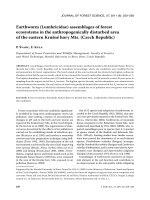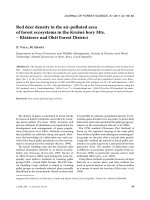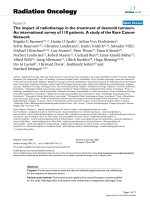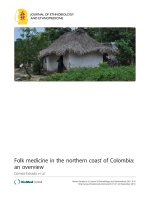Pre cenozoic tectonic deformation phases in the muong xen area, nghe an province VJES 38
Bạn đang xem bản rút gọn của tài liệu. Xem và tải ngay bản đầy đủ của tài liệu tại đây (1.84 MB, 12 trang )
Vietnam Journal of Earth Sciences Vol 38 (2) 166-177
Vietnam Academy of Science and Technology
Vietnam Journal of Earth Sciences
(VAST)
/>
Pre-Cenozoic tectonic deformation
Muong Xen area, Nghe An province
phases
in
the
Nguyen Ba Minh*1, Nguyen Van Vuong2
1
General Department of Geology and Minerals of Vietnam
University of Science, Vietnam National University, Hanoi
2
Received 6 April 2016. Accepted 23 May 2016
ABSTRACT
The Ca River fault zone, located in the North-Central Vietnam, is one of the most complicated deformation zones
with very low grade metamorphism but high intense folding. Investigations of deformation conducted in the Muong
Xen area, northwest of the Ca River fault zone, show that, the Ca River fault zone had undergone at least three
deformation phases before the Cenozoics. The first (oldest) deformation phase is characterized by recumbent, reverse
folds and overthrust faults in NW-SE direction. The second deformation phase is characterized by large scale Zshaped folds that deformed oder structures. Those structures are covered by a pre-Late Triassic angular unconformity.
The third deformation phase refolds previously formed structures and shows similar characteristics of folding as the
first phase. These structures were subsequently deformed by Cenozoic tectonics.
Keywords: Ca River fault zone; Pre-Cenozoic defomation; Recumbent folds; Z-shaped folds; Pre-Late Triassic
angular unconformity.
©2016 Vietnam Academy of Science and Technology
1. Introduction
The Ca River fault zone is located in Nghe
An, Ha Tinh provinces, and partly in northern
Quang Binh province. Geologically, the fault
zone is limited by route 48 faults in the north
and Rao Nay fault to the south. Up to date, a
number of studies on structural tectonics in
this area have been conducted (Nguyen, 1987;
Phan, 1995; Bui et al., 1996; 2001; 2002;
2005; 2008; Lepvrier et al., 1997; 2003; 2008;
Cao et al., 1998; 2002; 2003; 2008; Nguyen,
1998; 2009; Ngo, 1999; Le et al., 2000; Le,
2003; Nguyen and Dao, 2004; Phan, 2005).
Regardless of having different views, most of
the authors showed that the Ca River fault
Corresponding author, Email:
166
zone experienced various tectonic activities in
three major periods, including Indosinian
(Permian - Triassic), Yanshan tectonic movements (Jurassic - Cretaceous) and Himalayan
tectonic movements (Cenozoic).
However, the nature and character of
tectonic deformations as well as their
effecting level on the regional structure plan,
especially the deformation phases occurred
before the Cenozoic remain unclear.
Geological mapped folds and faults of this
area are not clearly depicted.
In this research, pre-Cenozoic deformation
characteristics will be presented for the Ca
River fault zone based on field observations
and geological mapping conducted in the
Muong Xen area, Nghe An, northwest of the
Ca River fault zone (Figure 1).
N.B. Minh and N.V. Vuong/Vietnam Journal of Earth Sciences 38 (2016)
Figure 1. Study area and location of observed cross sections (red lines)
2. Geological setting of the Muong Xen area
2.1. Stratigraphy and magmatics
According to the geological map at
1:50,000 scale of Muong Xen sheet group
(Nguyen et al., 2005), the geological formations in the Muong Xen area are distributed
along two sides of the Ca River fault zone,
including mainly stratigraphic and magmatic
formations of Late Ordovician to Late
Triassic ages.
Stratigraphically, the study area expose
of Early-Middle Paleozoic terrigenous
formations of the Ca River Formation (O3Ssc) and Huoi Nhi Formation (S3-D1hn);
Early Devonian - Early Carboniferous
terrigenous carbonate formations of Huoi Loi
Formation (D1-2hl), Nam Kan (D2g-D3frnk)
and Khanh Thanh Formations (D3-C1kt);
Carboniferous - Permian carbonate - siliceous
formations of La Khe Formation (C1lk) and
Muong Long Formation (C1-Pml); Middle
Triassic sedimentary - rhyolite eruption
formations including Dong Trau Formation
(T2adt) and coarse debris sediments of Dong
Do Formation (T3n-rdd).
The igneous formation includes Phia Bioc
granitoidic complex (γP3-T1pb), a member of
the regional Late Permian - Early Triassic
magmatic series.
2.2. Structural - tectonic features
The sedimentary rocks of different ages
exposed along the Ca River fault are strongly
deformed with complex folding systems.
However, the grade of accompanied metamorphism is inconsistently low, corresponding to
the lowest of greenschist facies, although
greensschist facies rocks can be occasionally
found along Song Ca fault zone.
On the current plan, the Ca River
deformed-faulted zone contains a series of
WNW-ESE faults and their branches. The Ca
River fault is linear - formed, extending from
Vietnam - Laos border running through
Muong Xen town and along the Nam Mo
River, almost matching the Ca River flow and
National Road No 7. The traces of the fault
167
Vietnam Journal of Earth Sciences Vol 38 (2) 166-177
segments can be observed over 40 km. Muong
Xen - Binh Chuan fault is a branch of the Ca
River fault. This fault starts from Muong Xen,
extending about 45 km in the sub-latitude
direction to the Ban Ve hydropower. These
are the two most important faults in the Ca
River fault zone.
3. Research methodology
Survey roadmap and data collecting folding and faulting characteristics at several cross
sections include: along the Ca River, from
Cua Rao to Kim Da; My Ly segment of the
Lam River; National Route No. 7, from Chieu
Luu to the Nam Kan border gate; routes from
Muong Xen town to Muong Long; and cross
sections at Huoi Thu and Huoi Heo streams.
Analyzing, interpreting, and synthetizing
survey documents to distinguish the tectonic
deformation phases were processed as
follows: division of deformation phases with
time, and expected ages of deformation
phases on the basis of field data on the properties of the folding system, the kinematics and
character of faults, the relationship between
the folding system and different faults,
combination of geological relationships observed in the area.
Structural tectonic mapping representing
geological structures, tectonic deformation
phases, folds and faults in the study area.
Microscopic analysis of structural petrographic samples was done at the Department
of Geology, VNU Hanoi University of
Science. Ar/Ar analysis for deformation age
was conducted at the University of
Montpellier II, France.
formations, including Ca River, Huoi Nhi,
Huoi Loi, Nam Kan, Khanh Thanh, La Khe,
and Bac Son Formations show that the earliest
deformation phase in the area is characterized
by
recumbent
to
isoclinal
folds
having horizontal-to-inclined axial plane
accompanied by reverse and overthrust faults,
with direction from NW-SE to sub-parallel.
These folds are commonly characterized by
NW-SE orientation, two limbs of the folds
making narrow or sub-parallel angles
observed at outcrops and cross- sections with
sizes from a few dozen centimeters to tens of
meters (Figure 2-5).
Figure 2. The recumbent folds (phase 1) with axis
surface 23515 (NW-SE), axial line (φ1): 70 <16, in
sandstone alternating with siltstone, shale of the Song
Ca Formation at Huoi Thu cross section (MX.2651).
Photo: Nguyen Van Vuong
4. Results
The study of deformation in the Muong
Xen area reveals that at least three deformation phases occurred in the Ca River fault
zone before the Cenozoic.
4.1. The first deformation phase
Field survey at the cross sections in
LateOrdovician - Middle Permian geological
168
Figure 3. Complex M-shape fold (phase 1): axial line
270 < 30 (Point MX.376 + 300m) at Ban Lan cross
section, South-Eastern Muong Xen town (about 3 km).
Photo: Nguyen Ba Minh
N.B. Minh and N.V. Vuong/Vietnam Journal of Earth Sciences 38 (2016)
Figure 4. Recumbent folds of phase 1 with
horizontal axial plane and NW-SE axial line, found in
sandstone alternating with shale exposed at the right
bank of Song Ca, Song Ca Formation, near Ban Ve
hydropower (MX.165 ). Photo: Nguyen Ba Minh
Along with the folding systems, there are
thrust and overthrust faults of NW-SE direction having relatively gentle slipping slope.
These faults were formed by progressive folding as a result of compressive deformation
(Figure 6). The overthrust faults was observed
at different scales from outcrops to microscopic thin sections (Figure 7).
Figure 5. Huoi Nhi - Huoi Thu cross section (northeastern Muong Xen town), found NW-SE folds (phase 1) in
sediments of Song Ca and Huoi Nhi Formations
The Ca River major fault is characterized
by dextral motion. The right lateral kinematic
indicator have been consistently observed
along the fault zone. Those indicators cover
wide range from sleeply plunging fold
axes (Figure 8, 9) to very realiable
indicators like S/C and rotaion of
porphyroblast/porphyroclast (Figure 10, 11).
169
Vietnam Journal of Earth Sciences Vol 38 (2) 166-177
Figure 6. Schistosity plane and overthrust fault developed
in the axial zone of the NW-SE folding structure, found in
Huoi Nhi claystone, siltstone, in northern Muong Xen town
(3 km) (MX.1853). Photo: Nguyen Van Vuong
Figure 7. Micro overthrust and dextral motion
observed in thin section. Samples collected at the Song
Ca, about 1 km from north Ban Ve, Tuong Duong,
Nghe An (MX.163). Photo: Vu Van Tich
Figure 8. The steep axial fold showed the nature of right Figure 9. The steep axial fold linked to the right strikeslip of Song Ca fault. Observations found in rhyolite
strike-slip of Song Ca fault. Observations found in the
extrusive of Dong Trau Formation (South Tuong
sand-siltstone of Song Ca Formation, on National Highway
Duong town, 3 km). Photo: Nguyen Van Vuong
No 7, southeast Muong Xen town, about 3 km (MX.376).
Photo: Nguyen Ba Minh
Figure 10. Structure of C/S (observed on the earh surface) Figure 11. Signs of right sliding movement directed
indicates dextral motion of the Muong Xen - Ban Ve fault
of Song Ca fault in the first deformation phase,
(F9) in shale - sericite of Song Ca Formation in the survey observed in pressed sandstone of Huoi Nhi Formation
point MX.581 (Ban Coi, right bank of Lam river).
(2 km from north Canh Trap).Photo: Nguyen Van Vuong
Photo: Nguyen Ba Minh
170
N.B. Minh and N.V. Vuong/Vietnam Journal of Earth Sciences 38 (2016)
4.2. Second deformation phase
Evidence of plastic - brittle deformation of
the second phase was recognized at the same
cross-sections as for the first phase. The structures formed in this phase consist of folds and
NE-SW overthrust faults.
At some outcrops and cross-sections, the
relationship of folding structures between the
first and second phase, in which, folds formed
in the first deformation phase were folded by
the second phase, forming typical Z-shaped
structure (Figure 12, 13). Folded structure
formed in the second deformation phase
changed those of the first phase into the
regional Z-shaped plan. Although being
deformed by the later phase, the structures
formed in the second phase are clearly recognized at some parts of the current geology
(Figure 14).
Figure 12. Interference of two first folding phases (NW-SE) and the second folding phase (NE-SW). Fold axis of the
first phase (φ1) is folded by the second phase (φ2). Observation point at the left bank of Song Ca, 1 km from north
Ban Ve in shales of Song Ca Formation (MX.162). Photo: Nguyen Van Vuong
Figure 13. Muong Xen - Muong Long section plan (through Pha Khao moutain village). Found folds of the phase 1,
NW-SE direction (bold dotted line with a dot), are folded by the phase 2, NE-SW (bold dotted line with two dots)
171
Vietnam Journal of Earth Sciences Vol 38 (2) 166-177
Figure 14. The regional geological map of Muong Long, northwest Nghe An. Found folded structures and overthrust
faults of phase 1 and phase 2 in this region (a: overthrust fault, Phase 1: filling red triangle, phase 2: empty triangle;
b: slip fault; c: unknown fault; d, e: phase 1 and phase 2 axis)
Activities of the second distortion phase
also distort reverse and overthrust faults of the
first deformation phase. Some overthrust
faults created by the second distortion phase
inherit the faults of the first distortion phase
but transformed from NW-SE to NE-SW
direction, these activities created overthrust
faults bent on the plan with NE-SW direction
(Figure 14).
along geological boundaries and altered the
surface of these boundaries.
4.3. The third deformation phase
The third deformation phase in the area
formed folds and overthrust faults of NW-SE
direction, coinciding with the trend of deformed structure in the first phase. They
distorted the Ordovician to late Triassic
geological formations and altered previously
formed structures (Figure 15, 16).
Reverse and overthrust faults formed in the
third phase are NW-SE or sub-parallel oriented. These faults constitute overthrust zones
cutting through many geological formations
of different ages, or sometimes developed
172
Figure 15. Dong Do Formation is covered with
unconformity on folded structures of the two early
deformation phases in Huoi Nhi Formation. This
unconformity boundary is to be turned into overthrust
fault (Pieng Hom - Huoi Thu overthrust fault) by
activity of later distortion phase. Observation points at
Pha Danh commune, near 15 km from north Muong Xen
town (MX.1862). Photo: Nguyen Ba Minh
N.B. Minh and N.V. Vuong/Vietnam Journal of Earth Sciences 38 (2016)
Figure 16. Huoi Heo cross section, northwestern Muong Xen town, about 12 km. Deformed activity of the phase 3
folded sediments of Dong Do Formation (T3n-rdd) (NW-SE)
An overthrust zone developed along the
boundary between La Khe and Dong Trau
Formations is observed in the My Ly area
(Figure 17). This evidence confirms the
occurrence of these faults after Late Triassic
(after the formation of Dong Do coal-bearing
sedimentary Formation). Ar/Ar age of a
granite from Muong Xen block (MX.219)
show a thermal tectonic age at 114 ±
4.9 Ma, corresponding to late Early Cretaceous
Figure 18.
Tectonic activities having occurred in the
three deformation phases established a
geological structural plan with complex systems consisted of multiple fold and overthrust
fault systems in the region (Figure 19). The
structures were then deformed by subsequent
brittle deformation activities in the Cenozoic
(Figure 20, 21).
Figure 17. Overthrust zone (slip surface 23555)
developed along the unconformity boundary between
Dong Trau and La Khe Formations. Observation point in
My Ly area (Northeastern Muong Long commune, about
5 km). Sliding grooves formed along the fault, in the
bottom gravel-breccia of the Dong Trau Formation
(MX.579 + 200m). Photo: Nguyen Ba Minh
Figure 18. A diagram determines isotopic age (114 ± 4.9 Ma) in biotite of granites in Muong Xen block, Ky Son,
Nghe An (sample MX.219).
173
Vietnam Journal of Earth Sciences Vol 38 (2) 166-177
Figure 19. Tectonic structural schema of Muong Xen region, western Nghe An, expression of folding and faulting
systems of different phases of Song Ca fault zone
174
N.B. Minh and N.V. Vuong/Vietnam Journal of Earth Sciences 38 (2016)
Figure 20. Right strike-slip fault with subparallel
direction, actived in Cenozoic and cut through pressed
sandstones and siltstones, The Song Ca Formation.
Viewpoint at Canh village, western Muong Xen town,
about 3km (CT.5). Photo: Nguyen Ba Minh
Figure 21. Normal fault, NW-SE direction, actived in
the Cenozoic and cut through sandstone of Dong Do
Formation (T3n-rdd). Viewpoint (MX.4630) in Phu
Sang (Ky Son, Nghe An). Photo: Nguyen Van Vuong
5. Discussion
(Norian), corresponding to an active period of
the Indosinian tectonic activities. Evidence includes geological relationships and absolute
ages as follows: (1) the activities of the two
deformation phases constitute folded structures and overthrust faults in geological
formations from Late Ordovician to Middle
Permian (including the Ca River, Huoi Nhi,
Huoi Loi, Nam Kan, Khanh Thanh, La Khe,
and Bac Son Formations); (2) the folded
structures of the two deformation phases in
the region are overlain angularly and unconformably by Dong Do late Triassic continental
sedimentary formation (T3n-r dd) as mentioned above; (3) a deformation age was
acquired from a mylonitized sandstone sample
in the Ca River Formation by Ar/Ar, and from
samples collected in the Keo Nua village, near
Cau Treo border gate, Ha Tinh yielded ages
ranging from 260 to 245 Ma (Nguyen, 1998).
Age of the third deformation phase was
estimated about Jurassic - Cretaceous, corresponding to a period of Yanshan tectonic
movements according to the following series
of evidence: (1) the activities of third phase
altered folded structures formed in two previous phases, while simultaneously affecting
Late Triassic sediments of Dong Do Formation (T3n-r dd); (2) the Ar/Ar age on
5.1. Interrelationship among deformation
phases
The study results acquired from the Muong
Xen area, Ca River fault zone, showed that
there were at least three deformation phases
having occurred before the Cenozoic. The
earliest phase was dominated by compression
accompanied by right strike-slip motion on
the major faults, in elastic - brittle state, forming folded structures having tilted to horizontal axial planes accompanied by reverse and
overthrust faults of NW-SE to sub-parallel
direction. The second deformation phase also
occurred in compression condition of elastic brittle state, forming NE-SW structures or
altering those formed in the first phase to
make Z-shaped structures. The third deformation phase also occurred under compression environment, of elastic - brittle state,
forming NW-SE oriented structures, coinciding with the trend of first phase, while altered
the previous structures.
5.2. Age of the deformation phases
The ages of two early deformation phases
in the study area are recorded to start by Late
Permian and ended before Late Triassic
175
Vietnam Journal of Earth Sciences Vol 38 (2) 166-177
granites of the Muong Xen block recorded
thermal tectonic events at 114 ±4.9 Ma, e.g.
by late Early Cretaceous; (3) the structures
formed in this phase were deformed and displaced by brittle deformation activities in the
Cenozoic.
6. Conclusions
Based on the geological mapping and
structural field observations, the following
conclusions could be drawn:
Before the Cenozoic, the Ca River fault
zone was affacted by at least 2 tectonic
movement periods, including the Indosinian
(Permian - Triassic) and Yanshan (Jurassic Cretaceous) expressed by three deformation
phases. The first two phases belonged to the
Indosinian tectonic movement, while the third
phase belonged to the Yanshan tectonic
movement.
The three pre-Cenozoic deformation
phases formed the regional structural geological plan of the Ca River fault zone. Folded
structures formed in the first two deformation
phases are characterized by NW-SE direction
and Z-shaped form. They were deformed and
displaced by brittle deformation in the Cenozoic, but the main structural features are still
preserved.
fracture systems). Journal of Earth Sciences, the Center for
Science and Technology, 23, 4, 362-369.
Bui Van Thom, 2002. Some characteristics of neotectonic
faulting in the North Central region, PhD Thesis. Institute
of Geological Sciences.
Bui Van Thom, 2005. Dynamic zone of neotectonic faults and
related geohazards in the North Central region. Journal of
Earth Sciences, 27, 3, 223-230.
Bui Van Thom, 2008. Neotectonic activity and its effects on the
development of geological hazards in the North Central
region. Proceedings of national scientific conference on
geological hazards and prevention solutions. Construction
Publishing House, 46-48.
Cao Dinh Trieu et al., 2003. The active fault zones in the
northern part of Vietnam’s territory. Journal of Geology, A,
279, 8-19.
Cao Dinh Trieu et al., 2008. Some features of seismotectonics
in Southeast Asia. Journal of Geology, A, 306, 3-13.
Cao Dinh Trieu, Nguyen Danh Soan, 1998. The main fault
systems in Vietnam’s territory on the basis of analysis of
gravity, magnetism and satellite images. Journal of
Geology, A, 247, 17- 27.
Cao Dinh Trieu, Pham Huy Long, 2002. Faulting tectonics in
Vietnam’s territory, Science and Technics Publishing
House.
in Da Krong - Hue fault zone. Journal of Geology, A, 267,
Claude Lepvrier, Henri Maluski, Nguyen Van Vuong, Delphine
Roques, Valerica Axente, Claude Rangin, 1997. Indosinian
NW-trending shear zones within the Truong Son belt
(Vietnam) 40Ar/39Ar Triassic ages and Cretaceous to
Cenozoic overprints. Tectonophysics, 283, 1-4, 105-127.
Claude Lepvrier, Henri Maluski, Vu Van Tich, A. Leyreloup,
Phan Truong Thi, Nguyen Van Vuong, 2004. The Early
Triassic Indosinian orogeny in Vietnam (Truong Son
Belt and Kontum Massif); implications for the geodynamic
evolution of Indochina. Tectonophysics, 393, 1-4, 87-118.
Claude Lepvrier, Nguyen Van Vuong, Henri Maluski, Phan
Truong Thi, Vu Van Tich, 2007. Indosinian tectonics in
Vietnam. Comptes Rendus Geoscience, 340, 2-3, 94-111.
Junlai Liu, Tran My Dung, Yuan Tang, Nguyen Quang Luat,
Tran Thanh Ha Jiafu Chen, Zhaochong Zhang, Zhidan
Zhao, 2012. Permo-Triassic granitoids in the northern part
of the Truong Son belt, NW Vietnam: Geochronology,
geochemistry and tectonic implications. Gondwana
Research, 22, 2, 628-644.
64-75.
Korea Mining Promotion Corporation, 1995. Report on the
Acknowledgments
This study was supported by the project
"Researching and constructing interdisciplinary database systems aiming to sustainable
development of the Northwest Việt Nam
region", code: KHCN-TB.01C/13-18.
References
Bui Van Thom, 1996. Findings of active characteristics of Song
Ca fault zone in Cenozoic. Geological Resources, Centre of
Science and Technology, Hanoi, Vol. I, 59-67.
Bui Van Thom, 2001. Characteristics of neotectonic activities
Bui Van Thom, 2001. Determination of the nature of active
fault zones in the North Central region (3 conjugate
176
joint geological and mineral survey in the Huong Khe area,
Ha Tinh province, Vietnam. Geological Archives.
N.B. Minh and N.V. Vuong/Vietnam Journal of Earth Sciences 38 (2016)
Le Duy Bach, Ngo Gia Thang, 2003. North Central tectonic
structure. Journal of Earth Sciences, 25, 1, 66-72.
Ngo Gia Thang, 1999. Faulting tectonics of Tuong Duong map
sheet group. Geology and Minerals of Vietnam, the 40th
anniversary of the establishment of the Northern
Geological Mapping Division, 194-212.
Nguyen Ba Minh ed., 2005. The geological and mineral map at
1:50,000 scale of Muong Xen map sheet group. Geological
Archives.
Nguyen Ba Minh, Dao Nguyen Viet, 2004. Structural - tectonic
features in Muong Xen zone, Nghe An. Geology and
Minerals of Vietnam, the 45th anniversary of the
establishment of the Northern Geological Mapping
Division, 117-128.
Nguyen Van Hoanh, 1987. Tectonic development history of
North Central Vietnam and its related endogenous mineral
resources. Doctor of Science Thesis on Geography Geology, Hanoi University of Mining - Geology.
Nguyen Van Vuong, 1998. Multiphase and coaxial tectonic
evolution of Central Vietnam during Mesozoic and
Cenozoic. Journal of Geology B, 11+12, 155-163.
Nguyen Van Vuong, 1998. Multiphase and coaxial tectonic
evolution of the North Central Vietnam folded system in
Mesozoic and Cenozoic. Abstracts of the 1st scientific
conference, VNU University of Science, Geology Sector,
21-22.
Nguyen Van Vuong, 2009. The fault zones in the
North
Central Vietnam. Geology and Resources of Vietnam.
Publishing House for Science and Technology, 427-429.
Nguyen Van Vuong, Claude Lepvrier, Phan Van Quynh,
Claude Rangin, 1995. Deformation along the Ca River
fault zone and Tertiary tectonics. Abstracts of Cenozoic
evolution of the Indochina peninsula, 77.
Phan Trong Trinh (Editor), 2005. Research on the effects of
neotectonics on geohazards in the North Central region.
The ministry-level scientific research project, Institute of
Geological Sciences.
Phan Truong Thi, 1995. Indosinia geoblock in the Indosinian
tectonic movement in Indochina and East Sea in Cenozoic.
Report in The third Scientific Conference on Geology,
121-136.
177









